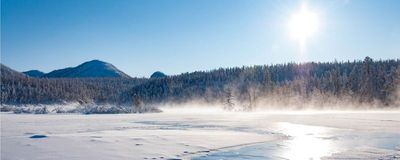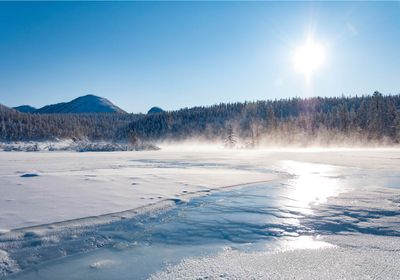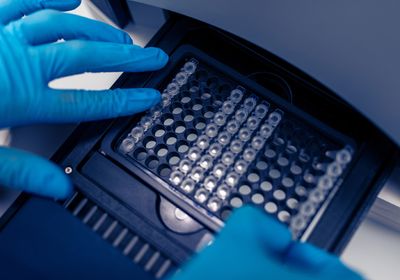ABOVE: This frozen river flows through Eastern Siberia. © iStock.com, Lina Shatalova
Microscopic worms unearthed from Siberian permafrost might belong to a species that went extinct elsewhere on Earth long ago. Researchers said that the tiny, 46,000-year-old nematodes use genes similar to those of their modern-day relatives to enter a state of hibernation where the worms can live indefinitely across tens of thousands of years. The findings were recently published in PLOS Genetics.1
In 2018, a team of scientists led by ecologist Anastasia Shatilovich at the Russian Academy of Sciences published experiments where they dug deep into permafrost near the Kolyma River in northeastern Siberia. The team burrowed 40 meters into the silty sediments of the Duvanny Yar outcrop, where a large portion of the riverbank has collapsed, exposing the long-frozen soil. There, the researchers dug up almost 300 samples, two of which contained a single nematode. The researchers revived both and, using radiocarbon dating, dated the soil and plant matter in these samples to 46,000 years ago.
After years of studying the genetics and morphology of the long-frozen nematodes, Shatilovich and her colleagues now claim that the reanimated worms are a previously-undescribed species—one from 46,000 years ago, making them the oldest living animals on the planet.
To learn more about the worms her team had found, Shatilovich brought them to cell biologist Teymuras Kurzchalia, who, at the time, was working at the Max Plank Institute of Molecular Biology and Genetics in Japan, but is now retired. “Anastasia came from Moscow with worms more or less in her pocket, which had survived 46,000 years, and I put them under microscope,” he recalled. “And I thought, this, wow, was really something.”
Surviving across time
While 46,000 years of survival is impressive, the nematodes aren’t the only animals to be pulled alive from the ice. Researchers believe that the permafrost at the Duvanny outcrop, and the creatures and plant matter within it, has remained frozen since the Pleistocene period. In the 1930s, Russian scientist P.N. Kapterev, a GULAG prisoner, who worked at the Skovorodino scientific station, found a crustacean buried in permafrost that, upon thawing, could move and eat. Since then, scientists have reanimated other microscopic creatures encased in permafrost, including rotifers and water bears, and sprouted long-dormant seeds.
Shatilovich, Kurzchalia, and their colleagues didn’t stop at reviving the animals. The researchers cultivated the revived nematodes for 100 generations, which took ages, according to Kurzchalia. It was also complicated by the fact that both individuals were females. Luckily, said Kurzchalia, they were parthenogenic.
Based on their uniform shape and size, the worms at first appeared to belong to one of two extant genera, Panagrolaimus or Plectus. But whole-genome comparisons with available nematode genomes indicated that they weren’t members of any current species. Instead, the long-hibernating creatures seem to be closely related to but distinct from other Panagrolaimus species, the researchers reported. The team also did extensive morphological characterization of the nematodes, finding that their shape and body size didn’t match any Panagrolaimus species that exist today.
“It is really a new species, ninety-nine percent likelihood,” said Kurzchalia. “It is Jurassic Park in a way.” Kurzchalia and his team decided to call this species Panagrolaimus kolymaensis after the Kolyma river where the specimens were discovered.
The researchers also sought insights into the biological processes that allowed the worms to live so long frozen in ice.
Other nematodes can live in extreme environments such as arid deserts and freezing tundras by entering a state of suspended animation known as cryptobiosis. In the study, members of Kurzchalia’s lab reported that they could induce this reversible metabolic shutdown in response to harsh desiccation in the commonly used model species Caenorhabditis elegans by first putting them in humid environments, then drying them out. But the dried-out worms only remained viable for about a week, Kurzchalia said. Simply freezing C. elegans kills them, although dehydrated and then frozen animals can survive for at least 500 days, and Kurzchalia said that he suspects that they can survive much longer, perhaps indefinitely.
With a complete genome, the researchers were able to probe whether P. kolymaensis has cryptobiosis-related molecular machinery similar to that of C. elegans. Comparative genomics revealed genes in P. kolymaenis that were similar to ones previously associated with cryptobiosis C. elegans, including genes for critical metabolic processes that help the worms produce trehalose, which Kurzchalia said is “the most important player” in surviving desiccation.
In response to freezing temperatures, trehalose takes on a gel-like state, which serves to protect cells and their contents, stabilize proteins, and prevent the formation of damaging ice crystals within cells. In C. elegans, humid environments spur trehalose production, depleting the animals’ lipid stores and preparing them to enter cryptobiosis. The researchers found that, like C. elegans, P. kolymaensis also produces the sugar in humid environments, and that this helps the animals enter cryptobiosis and remain viable after desiccation. However, for some members of P. kolymaensis, an increase in humidity before desiccation wasn’t necessary for them to enter hibernation.
Dead or alive?
Dan Shain, a biologist at Rutgers University who was involved in similar work in rotifers in permafrost, wrote in an email that what he found most surprising is that the common and widely studied lab nematode C. elegans is also apparently capable of long-term survival. So it’s not just “a few exotic and highly evolved outlier species that can do it, but rather it seems like a broad range of animals potentially has the machinery to transition into a cryptobiotic state,” he said. Shain did not work on the current paper but has collaborated with some of its authors in the past.
“We are showing that these worms have the same or at least similar mechanisms to go into cryptobiosis,” said Kurzchalia. “Nature has made something universal to survive across time.”
The authors said that they hope that this type of research will lead to more research into how nematodes evolved and maintain the ability to survive for such prolonged time periods. Kurzchalia also hopes that scientists may be able to induce cryptobiosis in other animals. “Nematodes are very complicated animals, but if they freeze their metabolism for an indefinite time, why couldn’t we do this in mammalian cells?” asked Kurzchalia. This type of technology could make longer-lasting organs, tissues, and blood, he said, as well as cells that could survive space travel.
Trehalose is toxic to mammalian cells, however, and vertebrates lack the enzymes to make it. And other questions remain, such as exactly how worms kick-start their cells and repair DNA damage after being frozen for so long, said Kurzchalia.
Previously, the team’s radiocarbon dating techniques had been criticized by other researchers, who said that the permafrost could have been contaminated with nematodes later in the geological timeline than their surroundings suggest.
“It is complicated anytime someone publishes a study showing antiquity. You can always question whether contamination was an issue or not,” said Amy Treonis, an ecologist at the University of Richmond who was not involved in the study.
What remains unclear is whether 46,000 years in permafrost is at or near the maximum possible cryptobiosis suspension time for this species. Shain said that it’s not likely the animals can survive indefinitely. “Eventually, the biological changes leading to death under temperate conditions will ultimately do the same during cryptobiosis,” he said.
Reference
- Shatilovich A et al. A novel nematode species from the Siberian permafrost shares adaptive mechanisms for cryptobiotic survival with C. elegans dauer larva. PLoS Genet. 2023;19(7):e1010798







